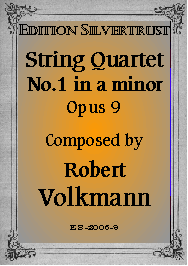Presents
Robert Volkmann
String Quartet No.1 in a minor, Op.9
 Friedrich
Robert Volkmann (1815-1883) was almost an exact contemporary of Wagner, however,
he certainly did not tread the same path as his fellow countryman. Volkmann
forever kept Beethoven in front of him as his model although he was later to
fall under the sway of Mendelssohn and then Schumann. In his day, Volkmann and
his music were highly regarded. Hans von Bülow, the famous conductor, noted that
when Liszt had a stranger visiting him, for whom he wished to provide a
superlative enjoyment, he played a Volkmann piano trio with Joachim the
famous violinist and the cellist Cossmann. Volkmann's second piano trio was often mentioned in
the same breath as Beethoven’s Op.97, “The Archduke.” High praise indeed
for a composer whose works today are nearly all out of print. During his
lifetime, Volkmann’s music was not only considered the equal of that of Schumann or Mendelssohn but also more advanced. It was commonly
recognized that Volkmann's music was the link between Schumann and Brahms. Ars Longa,
vita brevis as the saying goes, but alas for Volkmann it was not only vita brevis but also fama brevis!
Friedrich
Robert Volkmann (1815-1883) was almost an exact contemporary of Wagner, however,
he certainly did not tread the same path as his fellow countryman. Volkmann
forever kept Beethoven in front of him as his model although he was later to
fall under the sway of Mendelssohn and then Schumann. In his day, Volkmann and
his music were highly regarded. Hans von Bülow, the famous conductor, noted that
when Liszt had a stranger visiting him, for whom he wished to provide a
superlative enjoyment, he played a Volkmann piano trio with Joachim the
famous violinist and the cellist Cossmann. Volkmann's second piano trio was often mentioned in
the same breath as Beethoven’s Op.97, “The Archduke.” High praise indeed
for a composer whose works today are nearly all out of print. During his
lifetime, Volkmann’s music was not only considered the equal of that of Schumann or Mendelssohn but also more advanced. It was commonly
recognized that Volkmann's music was the link between Schumann and Brahms. Ars Longa,
vita brevis as the saying goes, but alas for Volkmann it was not only vita brevis but also fama brevis!
Though born and schooled in Germany, (he studied at Freiburg & Leipzig), Volkmann, after a brief stint in Prague, got a job in Pest in 1841 and made friends among the large German community there. Though he went to Vienna in 1854, he missed Pest and moved back in 1858 where he remained for the rest of his life.
String Quartet No.1 was composed in 1847-8 during his first sojourn in Pest, but not published until he moved to Vienna in 1854. Regarded as modern-sounding at the time, today it does not sound so to us, but one should keep in mind that it was published when Brahms was but 21 and Schumann still alive. The lengthy, slow introduction of the Largo-Allegro non troppo builds an incredible amount of suspense and is reminescent of late Beethoven structurally with its long silences. After it fades away ppp, without warning, the Allegro literally explodes, moving forward with tremendous energy and drama. (Our soundbite begins here) The center of gravity in this quartet is clearly in the mammoth Adagio molto. The first subject, which is of great simplicity, is made to sound, through the use of triplets, like a slow-motion minuet. But what develops is of considerable complexity, not only rhythmically but thematically as well. A captivating Presto follows and is a headlong gallop which only stops for breath in a somewhat slower and more lyrical middle section. In the finale, Allegro impetuoso, one hears echoes of Beethoven, especially in the opening sustained notes, but the writing is pure Volkmann. This fine work will certainly give much pleasure to amateurs and deserves performance in concert. It presents no great technical demands on the players.
Parts: $24.95